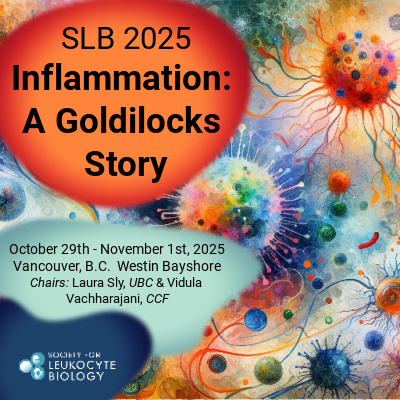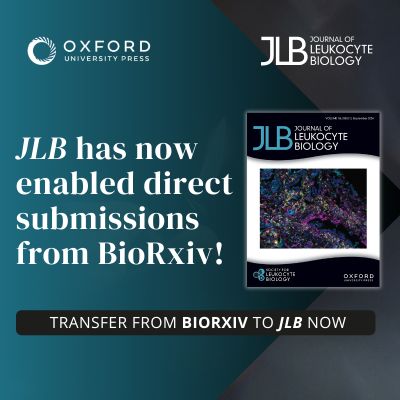| JLB Vol 112 Issue 5 TOC |
ISSUE INFORMATION Issue InformationPages: 941-947 | First Published: 26 October 2022 EDITORIALS PMN‐MDSC in newborns: Regulation of the regulators Jadwiga Jablonska, Sven Brandau
Pages: 949-950 | First Published: 10 August 2022 Put them to bed, and “do not disturb” brain microglia in SIV infection Dennis Kolson
Pages: 951-953 | First Published: 16 August 2022 SPOTLIGHT ON LEADING EDGE RESEARCH Mechanisms regulating transitory suppressive activity of neutrophils in newborns: PMNs‐MDSCs in newborns Michela Perego, Shuyu Fu, Yingjiao Cao, Andrew Kossenkov, Meng Yao, Erin Bonner, Kevin Alicea-Torres, Wangkai Liu, Zhilong Jiang, Zhihong Chen, Serge Y. Fuchs, Jie Zhou, Dmitry I. Gabrilovich
Pages: 955-968 | First Published: 21 June 2022 Antiretroviral therapy restores the homeostatic state of microglia in SIV‐infected rhesus macaques Andrew J. Trease, Meng Niu, Brenda Morsey, Chittibabu Guda, Siddappa N. Byrareddy, Shilpa Buch, Howard S. Fox
Pages: 969-981 | First Published: 10 June 2022 REVIEWS Physiologic roles of P2 receptors in leukocytes Anael Viana Pinto Alberto, Natiele Carla da Silva Ferreira, André Gustavo Calvano Bonavita, Oscar Kenji Nihei, Fernando Pires de Farias, Rodrigo da Cunha Bisaggio, Cristóvão de Albuquerque, Wilson Savino, Robson Coutinho-Silva, Pedro Muanis Persechini, Luiz Anastacio Alves
Pages: 983-1012 | First Published: 15 July 2022 Metabolic regulation of type 2 immune response during tissue repair and regeneration Tian Ding, Shaohua Ge
Pages: 1013-1023 | First Published: 23 May 2022 Immune senescence and periodontitis: From mechanism to therapy Jiaqi Liu, Ruichen Dan, Xueman Zhou, Jie Xiang, Jun Wang, Jin Liu
Pages: 1025-1040 | First Published: 11 October 2022 Galectin‐3 as a biomarker in breast neoplasms: Mechanisms and applications in patient care Doudou Georges Massar Niang, Folly Mawulolo Gaba, Adame Diouf, Jacobus Hendricks, Rokhaya Ndiaye Diallo, Maguette Deme Sylla Niang, Babacar Mbengue, Alioune Dieye
Pages: 1041-1052 | First Published: 20 September 2022 COVID-19 INITIATIVE Single‐cell immune profiling reveals long‐term changes in myeloid cells and identifies a novel subset of CD9+ monocytes associated with COVID‐19 hospitalization William J. Pandori, Lindsey E. Padgett, Ahmad Alimadadi, Norma A. Gutierrez, Daniel J. Araujo, Christine J. Huh, Claire E. Olingy, Huy Q. Dinh, Runpei Wu, Pandurangan Vijayanand, Serena J. Chee, Christian H. Ottensmeier, Catherine C. Hedrick
Pages: 1053-1063 | First Published: 22 July 2022 CELL DEVELOPMENT, DIFFERENTIATION AND TRAFFICKING Ginsenoside Rg1 ameliorates sepsis‐induced acute kidney injury by inhibiting ferroptosis in renal tubular epithelial cells Jun Guo, Rong Wang, Fei Min
Pages: 1065-1077 | First Published: 30 June 2022 RECEPTORS, SIGNAL TRANSDUCTION AND GENES IL‐17A produced by invariant natural killer T cells and CD3+CD56+αGalcer‐CD1d tetramer– T cells promote liver fibrosis in patients with primary biliary cholangitis Hongyu Jia, Jianing Chen, Xujun Zhang, Kefan Bi, Hetong Zhou, Tianxing Liu, Jia Xu, Hongyan Diao
Pages: 1079-1087 | First Published: 22 June 2022 INFLAMMATION, EXTRACELLULAR MEDIATORS AND EFFECTOR MOLECULES BRAF‐V600E utilizes posttranscriptional mechanisms to amplify LPS‐induced TNFα production in dendritic cells in a mouse model of Langerhans cell histiocytosis Danielle Minichino, Kaosheng Lv, Niansheng Chu, Wei Tong, Edward M Behrens
Pages: 1089-1104 | First Published: 01 June 2022 IL‐7 induces type 2 cytokine response in lung ILC2s and regulates GATA3 and CD25 expression Abdalla Sheikh, Julia Lu, Etienne Melese, Jung Hee Seo, Ninan Abraham
Pages: 1105-1113 | First Published: 23 May 2022 HOST DEFENSE AND PATHOPHYSIOLOGY IgM+ and IgM– memory B cells represent heterogeneous populations capable of producing class‐switched antibodies and germinal center B cells upon rechallenge with P. yoelii Susie L. Brown, Jonathan J. Bauer, Juhyung Lee, Enatha Ntirandekura, Jason S. Stumhofer
Pages: 1115-1135 | First Published: 03 June 2022 Notch regulates Histoplasma capsulatum clearance in mouse lungs during innate and adaptive immune response phases in primary infection Shuo Huang, George S. Deepe Jr.
Pages: 1137-1154 | First Published: 23 May 2022 TRANSLATIONAL AND CLINICAL IMMUNOLOGY Gender‐dependent frequency of unconventional T cells in a healthy adult Caucasian population: A combinational study of invariant NKT cells, γδ T cells, and mucosa‐associated invariant T cells Parvind Singh, Marianna Szaraz-Szeles, Zoltan Mezei, Sandor Barath, Zsuzsanna Hevessy
Pages: 1155-1165 | First Published: 19 May 2022 Achieving intracellular cytokine staining assay concordance on two continents to assess HIV vaccine‐induced T‐cell responses One B. Dintwe, Stephen C. De Rosa, Yunda Huang, Britta S. Flach, Bryce Manso, Don Carter, Faatima Laher Omar, Katharine V. Schwedhelm, Chenchen Yu, Huiyin Lu, Daryl Morris, Jia Jin Kee, Valentin Voillet, Michael Stirewalt, John Hural, Zoe Moodie, Nicole Frahm, Kristen W. Cohen, M. Juliana McElrath, Erica Andersen-Nissen
Pages: 1167-1181 | First Published: 22 July 2022 Early differentiated CD28+ CD27+ T lymphocytes as a biomarker for short and long‐term outcomes in older patients with pneumonia Teresa Franco-Leyva, Olga H. Torres, María Encarnación Saez Prieto, Gemma Boera-Carnicero, Álvaro Santos, Sandra Clotet, Daniel Albert-Jares, Yasmin El-Ebiary, Manuela Agustí-Martí, Jordi Casademont, Cándido Juárez, Laura Martínez-Martínez
Pages: 1183-1190 | First Published: 23 June 2022 SYSTEM BIOLOGY AND IMMUNOGENETICS In silico design of a TLR4‐mediating multiepitope chimeric vaccine against amyotrophic lateral sclerosis via advanced immunoinformatics Kiarash Saleki, Mohamad Hosein Mohamadi, Mohamad Banazadeh, Parsa Alijanizadeh, Nima Javanmehr, Ramtin Pourahmad, Hamid Reza Nouri
Pages: 1191-1207 | First Published: 16 June 2022 INFLAMMATION, EXTRACELLULAR MEDIATORS AND EFFECTOR MOLECULES GPR15 expressed in T lymphocytes from RA patients is involved in leukocyte chemotaxis to the synovium Julio Cesar Fernández-Ruiz, Fátima de Lourdes Ochoa-González, Martín Zapata-Zúñiga, Eduardo Mondragon-Marín, Edgar E. Lara-Ramírez, Jose Luis Ruíz-Carrillo, Paola Amayrani DelaCruz-Flores, Esther Layseca-Espinosa, José Antonio Enciso-Moreno, Julio Enrique Castañeda-Delgado
Pages: 1209-1221 | First Published: 27 September 2022 Meeting: Targeted Science Issue - Macrophage Infection by HIV 2021 Guest Editors: Kiera Clayton, Janice Clements, and Mario Stevenson REVIEWS Advancing basic and translational research to deepen understanding of the molecular immune‐mediated mechanisms regulating long‐term persistence of HIV‐1 in microglia in the adult human brain Thomas Boucher, Shijun Liang, Amanda M. Brown
Pages: 1223-1231 | First Published: 25 May 2022 Role of macrophages in HIV pathogenesis and cure: NIH perspectives Jeymohan Joseph, William Daley, Diane Lawrence, Eric Lorenzo, Peter Perrin, Vasudev R. Rao, Shang-Yi Tsai, Vasundhara Varthakavi
Pages: 1233-1243 | First Published: 08 September 2022 Clearance of HIV‐1 or SIV reservoirs by promotion of apoptosis and inhibition of autophagy: Targeting intracellular molecules in cure‐directed strategies Min Chen, Min Li, Marietta M. Budai, Andrew P. Rice, Jason T. Kimata, Mahesh Mohan, Jin Wang
Pages: 1245-1259 | First Published: 31 March 2022 Mechanisms of HIV‐1 cell‐to‐cell transfer to myeloid cells Mingyu Han, Marie Woottum, Rémi Mascarau, Zoï Vahlas, Christel Verollet, Serge Benichou
Pages: 1261-1271 | First Published: 31 March 2022 Current strategies to induce selective killing of HIV‐1‐infected cells Grant R. Campbell, Stephen A. Spector
Pages: 1273-1284 | First Published: 16 June 2022 Animal models for studies of HIV‐1 brain reservoirs Emiko Waight, Chen Zhang, Saumi Mathews, Bhavesh D. Kevadiya, K. C. Kent Lloyd, Howard E. Gendelman, Santhi Gorantla, Larisa Y. Poluektova, Prasanta K. Dash
Pages: 1285-1295 | First Published: 31 August 2022 Shock and kill within the CNS: A promising HIV eradication approach? Marieke M. Nühn, Stephanie B. H. Gumbs, Ninée V. E. J. Buchholtz, Lisanne M. Jannink, Lavina Gharu, Lot D. de Witte, Annemarie M. J. Wensing, Sharon R. Lewin, Monique Nijhuis, Jori Symons
Pages: 1297-1315 | First Published: 23 September 2022 PRIMARY RESEARCH Morphine disrupts macrophage functions even during HIV infection John M. Barbaro, Matias Jaureguiberry-Bravo, Simone Sidoli, Joan W. Berman
Pages: 1317-1328 | First Published: 07 October 2022 Dysregulation of the IFN‐I signaling pathway by Mycobacterium tuberculosis leads to exacerbation of HIV‐1 infection of macrophages Maeva Dupont, Stella Rousset, Thien-Phong Vu Manh, Sarah Catherine Monard, Karine Pingris, Shanti Souriant, Zoï Vahlas, Tomàs Velez, Renaud Poincloux, Isabelle Maridonneau-Parini I, Olivier Neyrolles, Geanncarlo Lugo-Villarino, Christel Vérollet
Pages: 1329-1342 | First Published: 19 May 2022 |


































